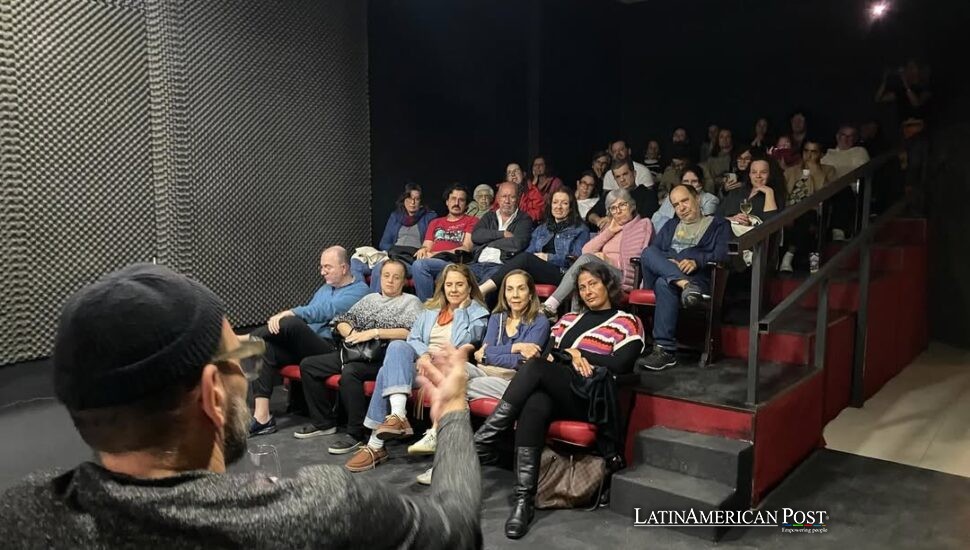In São Paulo, a One-Man Cinema Keeps Brazil’s Movie Dreams Alive

On a quiet backstreet in São Paulo, a childhood promise flickers to life every evening when the lights dim at Cine LT3. This 35-seat shoebox of a cinema, stitched together from savings, scavenged seats, and stubborn faith, argues that Brazil’s film future still has room for small, human-scale screens.
A One-Man Theater in a City of Malls
For Carlos Costa, the story began half a century ago, in the dark of a movie theater beside his grandmother. “When I saw that giant screen, wow, I was mesmerized. I thought: someday I’ll have a movie theater of my own,” he told the AP.
Fifty years later, that boy’s vow became a garage reborn. Costa spent about 100,000 reais to convert the back of his production studio—shuttered during the pandemic—into a 35-seat refuge for cinephiles. He salvaged wooden chairs from a rural theater, arranged them in neat rows, and hung a modest screen where cars once idled.
There is no staff. No hierarchy. Just Carlos. “The movie theater is just me. I project the films, make the popcorn, sell the tickets, everything,” he said. You buy a ticket via WhatsApp, walk in to the smell of butter and old wood, and greet the proprietor by name. Between showings, he sweeps the floor, tests the projector, and remembers why he started.
In an age when screens have multiplied but moviehouses have shrunk into mall corners, Cine LT3 feels radical. It offers accountability in place of anonymity—a handshake instead of a barcode.
The Last Stand of Stand-Alone Screens
Across Brazil, the lights are going out on independent cinemas. Nearly 90% of the country’s 3,542 screens now sit inside shopping malls, according to government data cited by the AP. Only 423 screens—like Costa’s—survive outside that world.
The rest have been demolished or converted into something else: evangelical churches, warehouses, adult theaters. Even the country’s great survivors, like Cine Belas Artes, remain open only because crowds refused to let them die. When Belas Artes faced closure, São Paulo protested—thousands of citizens rallying to keep a marquee glowing.
Costa sees Cine LT3 as part of that lineage. “Independent theaters are very important because they have a completely different appeal,” said Maria Amélia Marcos, a 71-year-old teacher visiting for the first time. She praised the “thoughtful selection” of films, telling the AP that small screens “make you think, not just consume.”
To Costa, those conversations—between strangers leaving a screening—are proof of why the effort matters. Stand-alone theaters are not nostalgia; they are civic spaces. They nurture curiosity, debate, and community. The price is fragility—measured in every rent bill, every broken seat, every week he wonders if the next showing will break even.
Still, he refuses to surrender to the mall. “If people want to talk to the person who chose the film, they can,” he said. “They know who they’re supporting.”
Programming as Point of View, Not Product
Costa programs with a curator’s eye and a fan’s heart. On the Thursday the AP visited, he screened a restored print of “Paris, Texas” as part of a citywide tribute to Wim Wenders on his 80th birthday. Another week, it might be a Brazilian indie too small for the multiplex, or a forgotten European gem.
He believes curation is an act of service. “No one leaves a movie theater the same way they entered,” Costa said. “That’s what I try to offer—a place where people are changed.”
Patrons can watch him live that mission in real time. “I see him selling tickets, making popcorn, cleaning, running the film, answering the phone,” said Maída Alves, 63, a regular. She told the AP that she loves watching Costa “as much as the movie itself.”
Outside, he has painted a mural of Toto, the projectionist’s apprentice from Cinema Paradiso. Inside, his rescued seats creak with history. When the credits roll, he turns to the audience, takes a breath, and asks, “What did you think?”
In an era when streaming algorithms anticipate desires before they’re spoken, Costa’s tiny theater is an act of resistance. It reminds viewers that art is not just something to watch—it’s something to share.
Why Small Cinemas Matter More Than Ever
Brazil’s movie habits have changed. Most tickets now sell inside shopping centers, and most screens compete not with one another but with living rooms and smartphones. Streaming is convenient but solitary. Cine LT3, by contrast, demands presence. It asks people to stop scrolling, to sit shoulder to shoulder in the dark and surrender to the same light.
“Going to a small cinema is different,” said Marcos. “You talk to people. You remember you’re part of something.”
That something is fragile. One broken projector bulb, one rent hike, and Costa’s one-man show could vanish. Yet the persistence of spaces like his proves that people still crave a shared experience—the laugh that ripples through a room, the quiet that falls when a scene lands, the applause that lingers before the lights come up.
If public policy had a soundtrack, Costa says, it should include the hum of projectors like his. Modest tax breaks or restoration grants could protect these cultural outposts. Distributors could adapt profit-sharing rules to acknowledge that 35 seats cannot compete with 350. But even without subsidies, the endurance of Cine LT3 depends on the simplest act of all: people showing up.
They do. They buy a glass of wine, sit in those rescued wooden chairs, and watch a film that no algorithm would ever recommend. They leave talking, sometimes arguing, always changed.
Costa remembers that first movie with his grandmother—how the screen filled his eyes and made the world feel endless. That memory is the fuel that keeps him unlocking the doors every night, no matter how small the crowd.
Also Read: Colombia’s Weavers Fight for Dignity in a World Hungry for Fashion
Brazil counts cinema screens by the thousands, but that number misses what truly matters. A country’s cultural health is measured not by how many people can watch, but by how many care enough to gather. In a city of malls and streaming menus, a garage in São Paulo still glows—a reminder that movies, at their best, are not consumed. They are shared.





